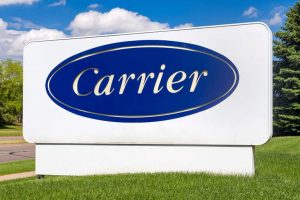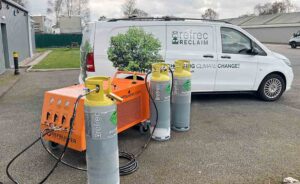Getting the best out of glycol
3rd August 2016 Glycol is fundamental to the smooth operation of chillers and chilled water systems. Brent Hall, technical manager at ICS Cool Energy, offers nine top tips to ensure its best performance.
Glycol is fundamental to the smooth operation of chillers and chilled water systems. Brent Hall, technical manager at ICS Cool Energy, offers nine top tips to ensure its best performance.
If specified incorrectly, Glycol can cause serious issues, including reduced heat transfer and corrosion. It’s not that difficult to save time and money by considering glycol specification and its effect on the operational life of a chiller system. Here are our top tips:
1. Never use automotive antifreeze
Automotive antifreeze is formulated for engine cooling rather than process or industrial cooling applications, so when it’s used for the wrong applications, it can cause problems with flow rates/pressures and reduced heat transfer. Many automotive antifreeze products are not glycol-based and contain other alcohols or glycerine, as well as silicate-based inhibitors, which can coat heat exchangers, attack pump seals, and form a gel, significantly affecting flow rates.
2. Only use inhibited glycol
Uninhibited glycol and water mixtures are very corrosive, often even more than plain mains water. Modern process and industrial glycols contain inhibitors alongside a pH buffer and biocide to protect against corrosion, scale formation, and rust. For a system to be contamination-free, it needs to be properly flushed, cleaned and sanitised before the addition of a suitable inhibited glycol and water mixture.
3. Don’t mix glycols
Different types and brands of glycol shouldn’t be mixed. Most modern glycols contain inhibitors and are dyed for identification. If they are accidentally mixed, incompatibilities can lead to separation and/or reaction, resulting in gel formation which will clog filters, strainers, and pump suctions, as well as causing a deterioration in heat carrying and transfer properties.
4. Checking your local environmental rules
Some areas have regulations regarding the use and disposal of particular glycols and antifreeze solutions, concerning things such as ground structure, the water table and drainage. Be sure to consult your local authority to check the local environmental rules.
Businesses should also consider using a bio-glycol as an environmentally-friendly solution. Bio-glycols are derived from a sustainable source and are non-toxic, non-flammable, non-hazardous, and biodegradable.
5. Be aware of the effects of antifreeze on a system
Plain water is one of the most efficient pumped fluids for absorbing and carrying heat. However, when any other chemical is added to it, this ability is affected. Adding glycol will cause an increase in the fluid’s viscosity and density, and decrease its heat transfer and heat carrying properties. These property changes will not affect the overall functionality of your chilling plant and system as long as they are understood and discussed beforehand as they will result in a slightly reduced cooling capacity, an increased pumping power consumption and an increased fluid temperature difference (or an increased fluid flow).
6. Use the correct water
Most systems use ordinary mains ‘tap’ water, and while good for human consumption, it can be quite damaging to any chiller and its associated machinery and systems. The relative hardness (and hence the mineral content) varies from region to region, so applying the appropriate inhibitors and biocide is of vital importance. Even microbiological contaminants vary, giving a degree of unpredictability to using town mains water or any other uninhibited water source. Using a ‘pure’ water – distilled, demineralised, de-ionised or RO water – will remove this unpredictability.
On its own, pure water can be damaging to heat exchangers due to its tendency to attack certain metals within the chiller and water circuit. It also has very low conductivity which can be a problem with some chillers and systems. We recommend the use of pure water with a suitable (minimum 20%) inhibited glycol mix to give the ultimate system protection. The added glycol will increase the solution’s conductivity to a level which is compatible with both the system materials and any conductivity-based instrumentation.
It is important to never use continuously de-ionised/polished water or any pure water without inhibited glycol.
7. Consider Ethylene glycol in process/industrial applications
Ethylene-based glycol is the standard process/industrial antifreeze additive and can be used in any application where low toxicity is not a requirement. In terms of efficiency losses, ethylene glycol has the least effect on flow rate, heat transfer capability, and pressure loss. However, ethylene glycol has moderate acute oral toxicity so should not be used in applications where it may come into contact with potable water, food and/or beverage processing.
8. Consider Propylene-based glycol for food and beverage applications
Propylene-based glycols have low toxicity and are the ideal antifreeze additives for applications in the food and beverage industry and where user contact is a frequent occurrence. For extra reassurance, make sure it has been tested by the National Sanitary Foundation, which is shown by a NSF mark. This is the assurance that the product is approved by an independent certification organisation that is valued by consumers, manufacturers, retailers, and regulatory agencies worldwide.
9. Maintain your chiller and system’s hygiene and fluid
The chilled water system and fluid used are the most important aspects to an installation. The water/glycol is the vehicle which collects the heat from the process and delivers it to the chiller, and the pipework is the road along which the fluid must travel. If either of these two are deficient in any way, the chiller’s operation will be compromised and the heat transfer capability will be reduced.
If necessary, filters/strainers should be installed and checked regularly, although the best policy is to tackle the source of any contamination. The chilled water system must be flushed, cleaned and sanitised prior to adding a new water/glycol solution. It must also be regularly sampled and tested to ensure there are no underlying or progressive contamination and/or corrosion issues.
For new, or recently cleaned and dosed systems, we recommend a test after three months of operation, including a comprehensive sample analysis. Thereafter, we recommend six monthly routine tests, along with regular visual examinations to check for colour and suspension.







